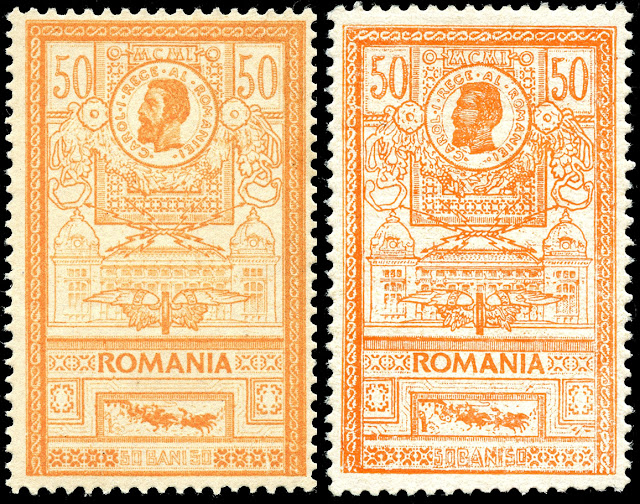This series was ordered in June, 1920. These issues, printed in Viborg, were designed by
Gustav Niemeyer of Germany.
North Ingria stamps were in use from 21 Mar – 5 Dec, 1920.
Counterfeit issues were apparently forged in Britain.
There is some speculation that Nino Imperato may have also been involved.
More forgeries appear to have surfaced in Europe in the 1980s and 1990s and are commonly available today.
Neither the genuine issues nor the counterfeits are known with watermarks. Most who have studied these forgeries conclude there are 3 varieties of each issue.
The forgeries exist on yellowish or extremely white paper. According to the Finnish forgeries manual, the yellowish paper forgeries were printed in sheets of 10x10 and the extremely white paper forgeries in sheets of 5x5.
The military commander of the Ingria regiment was paid with about 12,000 sheets of the first issue which he apparently sold to dealers & collectors. This may account for many of the originals in circulation.
 |
| Invert. Ovpt. Fake |
Most used stamps are CTO's from the large quantity of remainders sold to a dealer in 1922.
They generally are cancelled with a a large, double-circle cancel of Kirjasalu with 1920's dates.
Ingermanland’s stamps were demonetized after the provisional government collapsed. But 5,000 sets of the penni values and 2,000 sets of the mark values were overprinted “Inkerin Hyväksi” (For the benefit of North Ingermanland ) and sold to aid refugees resettling in Finland. Inverted overprints are known on the 10- and 80-penni values.
CTO's
Most used stamps are CTO’s from the large quantity of remainders sold to a dealer in 1922.
They generally are cancelled with a a large, double-circle cancel of Kirjasalu with 1920’s dates.
A general guide to the forgeries includes:
The majority are on white paper
The colors are brighter than the originals
Those with gum show brush marks
Many will have rough perforations, however so do some originals
Generally the paper is larger & the design tends to be off center
10p
 |
10p Original
|
Forgeries
10p Type I features left
1. Double line instead of a single one
2. J is tilted to the right
3. Blue notch in corner (may not be on all)
4. Larger, heavier dots than the genuine
5. Left top corner rounded instead of square.
6. Minor differences in hieroglyphics.
The right forgery is the Type II
Poorly centered
Darker cream colored paper
No blotch as Type I #3.
In many ways, this forgery seems to be a copy of the Type I forgery with modifications.
It is not uncommon that a forger would take a known or unknown example of a forgery and copy it while making some slight changes
Lithographed with gum. The centre is missing in the top row. Perforated 11.5
In the Coat of Arms there is always a dot in the right upper corner
Lithographed, unperforated and ungummed. The centre is printed twice, the second printing is misplaced. The colour is brighter than in the originals. Printed in sheets of 5 x 5.
In the Coat of Arms there is always a dot in the right corner
30p |
| 30p Original |
Forgeries
30p Type I features left
1. Brighter overall color
2. J more inclined & opening in curve wider.
3. Dots in background instead of lines.
4. Curve end in right foot not pointing up.
5. Right upper oblique very thin.
6. Coarse lines with blank or dark joined lines.
The right forgery is the Type II
The paper is darker cream colored
Overall the stamp is larger
The letters are different note in particular the last 3 of POHJOIS
50p
Forgery
50p Forgery Features - right
1. Openings in numerals larger & 5 is far away from the dash frame.
2. Tip is pointed instead of round.
3. Several ovals have outside line missing.
4. Loop is not closed.
5. Inside lines touching outside curves forming O's.
6. Pointed instead of rounded.
7. Base of E curves up instead of being flat.
8. On some the hoof does not touch the ground.
80p
Original Imperf pair
Forgery
1. Base of J curved and lower left side is inclined downwards instead of being straight.
2. Coarse heavy lines.
3. Milk can almost invisible.
4. Shapes are not as oval as genuine.
5. Cow appears to be wearing glasses.
6. Color much brighter.
7. Bottom of both I's not curved in as with genuine.
1m
Genuine perf error
Forgery
1. Brighter overall color.
2. Kneeling figure indistinct.
3. Dash not touching tip of curve to the right
4. Dot(s) instead of continuous line as in genuine.
5. Coarse lines instead of the fine ones in the genuine.
6. Coarse lines joined & with empty spots.
Crude imperf forgery
5m
Forgery
5m Forgery Features
1. Diamonds much smaller , irregular in size & far away from white inner oval.
2. Part of ornament missing
3. Coarser design overall.
4. Background lines much coarser than genuine
5. Ovals are flatter & some have almost flat sides.
10m
Forgery
10m Forgery Features
1. Darker, deeper color than original.
2. Coarser lines than original.
3. This dot is (was) considered a positive for forgeries but some genuines have it (see left one). It may be a plate flaw that was copied by the forgers.
4. The ovals should have 2 distinct lines & not be shaded completely.
5. Deep notches missing & both elements should be much closer together.
6. Background lines much coarser than in the genuine.
Genuine overprint
There are many errors and varieties which might faked for collectors.
There is note that one inverted sheet of the 10m exists as the APS certified copy below
However, this one inverted sheet would mean there was only 100 available, yet many show up on auctions with and without certificates?
Often you can find proof of only the frames, these exist but I am not aware of forgeries
Imperf & perfed forgeries






































